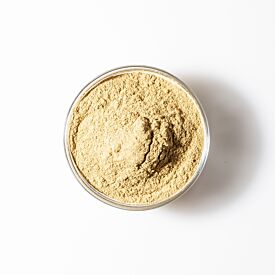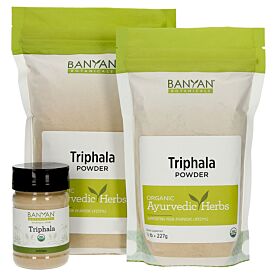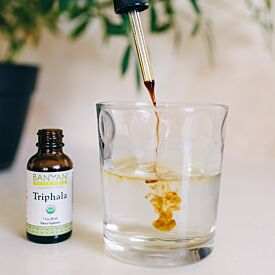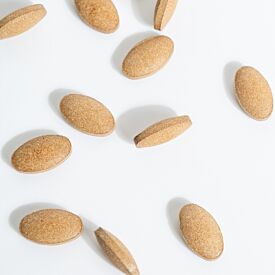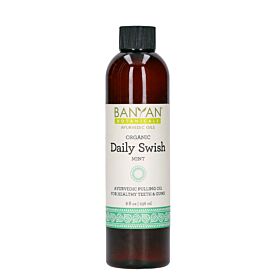The Top 7 Ways to Use Triphala
Triphala is Ayurveda’s most widely used herbal formula—which is one of the reasons Banyan offers a full organic triphala product line. What you might not know is that triphala powder is not only the most traditional way to take this powerful combination of amalaki (or amla), haritaki, and bibhitaki—it also offers an extremely versatile method of using it.
While triphala powder is most commonly made into a warm tea to support a healthy digestive system, there is much more to the powers of this most ancient of Ayurvedic blends. Here are seven of our favorite ways to use the powdered version to unlock those triphala benefits!
1. Use Triphala as a Hair Rinse for Dry or Damaged Hair
You might be surprised to learn that you can use triphala powder for hair treatments, but the process is fairly simple and oh so worth it!
Start this pick-me-up treatment for your hair by boiling 4 tablespoons of triphala powder with 1 quart of water. If your hair is dry, frizzy, or depleted, add 2 tablespoons of sesame oil. Allow the decoction to boil for 10 minutes before removing from the heat to cool (straining is not necessary).
Once the hair wash has cooled to a comfortable temperature, lean over a sink or bathtub and slowly pour the wash over your hair, pausing every now and then to massage it through. If you have time, wait 30 minutes or more before washing your hair normally.
This clarifying treatment can be done weekly to encourage vibrant color and thick healthy hair.

2. Make a Triphala Eye Wash
To do this, make a triphala tea by boiling ½ teaspoon triphala powder in 1 cup of water for 2 minutes. Then strain the tea several times until there are absolutely no particles left in the tea. This is very important to ensure that the eye wash does not cause irritation. Once you have used a cheesecloth (doubled over) to thoroughly strain the tea, let it completely cool before washing the eyes.1
Use an eye washing cup if you have one, using half of your eyewash for one eye and half for the other. Blinking while washing helps circulate the tea and cleanse the area more thoroughly.
This practice is a very traditional way to use the clarifying and rejuvenating qualities of triphala for eyes. It is especially helpful after a long day of reading or time spent in front of a computer screen.
Keep in mind that we always recommend consulting with an Ayurvedic practitioner or healthcare provider before trying an eye wash, especially if you have a medical condition in or around your eyes.
3. Create a DIY Skin Cleanser
Triphala can be used as a skin cleanser in two ways. For an exfoliating experience, mix triphala powder with enough warm coconut oil to make a paste and gently scrub the areas of your skin that could use some invigoration. Any areas of dead or calloused skin will love this treatment. For areas of dull or discolored skin, apply the paste and let it sit for 10 minutes before rinsing it off with warm water.
For more sensitive areas, make a triphala tea and strain it through a fine cloth. Once cool, use the tea to carefully wash your skin. This can be useful on non-cystic acne or areas of skin that are excessively oily.
4. Brush Your Teeth with Triphala Powder
It doesn’t taste great, but your mouth will thank you for it! The astringent qualities of triphala help remove the build-up of toxins on the teeth, gums, and tongue. In fact, clinical studies have shown that triphala can be effective at removing plaque and buildup from the teeth, among other benefits.2
Mix a small amount of triphala powder with enough warm water to form a paste. Use your toothbrush to scrub the teeth and gently massage the gums. The triphala is deeply cleansing and may leave your mouth feeling slightly dry, so follow with a rinse of warm water, or a few minutes of oil pulling with Daily Swish Oil.
For extra-sensitive, red, or irritated gums, try a triphala mouthwash instead of the herbal toothpaste. Simply make triphala tea, strain well, and once cool, swish and gargle the tea to cleanse the mouth without causing irritation.
If you find triphala's qualities too drying for your mouth, you can try using powdered amalaki instead for a similar cleansing—but less astringent—experience.
5. Cleanse Your Scalp with Triphala
Triphala scrapes away the natural buildup of toxins on the scalp when applied topically.
To make a scalp scrub, mix 1 tablespoon of triphala powder with 1 tablespoon neem powder and moisten with enough water to make a paste similar to the consistency of pancake batter. Use your fingertips to massage the paste into the scalp and exfoliate the skin, paying extra attention to the areas that tend to accumulate the most oils. Add a few drops of tea tree oil if you’re prone to a flaky scalp.
For a deeper cleansing effect, let the paste set on the scalp for 20 minutes before rinsing.
6. Mix Up Some Triphala Jam
In Ayurveda, honey and ghee, when combined, act as a sort of “divine nectar,” carrying the herbs they are paired with deep into the tissues.
This rejuvenating recipe is ideal for balancing vata, recovering from stress, and building ojas, the juiciness of the body.
Mix 1 tablespoon ghee, 1 tablespoon honey, and 1 teaspoon triphala powder for a sweet, nourishing jam to take in the mornings or evenings in place of plain triphala.
Keep in mind that Ayurveda cautions against combining ghee and honey in equal amounts according to weight. That said, it is known to be healthy and beneficial when combined in equal volume, as in this recipe.
7. Drink Triphala Tea Every Day
And the most traditional method of how to take triphala is by making triphala tea. Daily intake of triphala tea can help promote:
- Regular, healthy bowel movements
- A strong immune system
- Thick hair and strong nails
- A healthy response to seasonal allergies, such as pollen
How does taking triphala tea support all of these actions in the body? By supporting the colon! The colon is one of the last stages of the digestive process, and one of the easiest places for ama, or natural toxins, to accumulate. This coating of toxins prevents the absorption and assimilation of essential food nutrients, and the nails, bones, and hair end up not receiving the nutrition they need to thrive.3
When triphala is taken on a regular basis, complete and regular bowel movements become the norm, and the colon is able to receive all the nutrients and nourishment needed for vibrant health and radiant beauty.
Triphala is best taken on an empty stomach, either last thing before you go to bed, first thing in the morning, or both.
The Post-Digestive Effect
Triphala is one of the most incredible substances in Ayurveda, partly because it has a fascinating prabhava—an unexpected effect.
It is commonly known that triphala cleanses and detoxifies, but it’s the post-digestive effect that is not as widely recognized. Once triphala has done its work in the body and made its way through the digestive system, it leaves the tissues not only cleansed, but also nourished, toned, and rejuvenated.
The three fruits of triphala all target different systems in the body, and together they create a synergistic formula that reaches into every tissue layer, or dhatu.
With so much versatility, it is no wonder that triphala is the most widely used, beloved herbal formula in Ayurveda. But one article can hardly encompass all of triphala's benefits! There is so much more to learn about this herbal combination, including its many benefits, scientific research, and contraindications to be aware of. Click here to continue discovering triphala!





